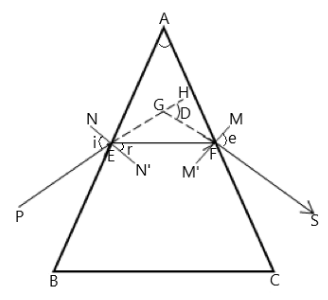
Identify the rays PE, EF, FS and angles r, D, e mentioned in the diagram.


Answer
551.1k+ views
Hint:A ray of light that strikes a surface is called an incident light. The angle between the incident ray and the normal to the surface is the angle of incidence. When an incident light ray passes through the second medium its direction changes, the ray is said to be a refracted ray and the angle between the refracted ray and the normal is called the angle of refraction.
Complete answer:
An incident ray of light on entering a prism gets refracted towards the normal. When the refracted ray strikes the other face of the prism, it is further deviated away from the normal and leaving the glass prism, it enters the air i.e. from one medium to the other. Thus the ray that emerges out of the other side of the prism is called the emergent ray. The angle made by the emergent ray with the normal at the surface is known as angle of emergence.
PE is incident on the prism, so PE is called the incident ray.On passing through the prism, PE gets refracted, so EF is called the refracted ray.The refracted ray EF then leaves the prism, so FS is called the emergent ray.Angle r is the angle between the normal and the refracted so it is called the angle of refraction.Angle D is the angle between the extended emergent ray and produced incident ray so it is called the angle of deviation.Angle e is the angle between the normal and the emergent ray so it is called the angle of emergence.
Note:Refraction is the change in direction of a wave passing from one medium to another due to the change of speed of wave in different medium. That’s why when a ray travels from a rarer medium to a denser medium it bends towards the normal and when a ray travels from denser to a rarer medium it bends away from the normal. At an angle of minimum deviation of the prism the refracted ray becomes parallel to the base of the prism.
Complete answer:
An incident ray of light on entering a prism gets refracted towards the normal. When the refracted ray strikes the other face of the prism, it is further deviated away from the normal and leaving the glass prism, it enters the air i.e. from one medium to the other. Thus the ray that emerges out of the other side of the prism is called the emergent ray. The angle made by the emergent ray with the normal at the surface is known as angle of emergence.
PE is incident on the prism, so PE is called the incident ray.On passing through the prism, PE gets refracted, so EF is called the refracted ray.The refracted ray EF then leaves the prism, so FS is called the emergent ray.Angle r is the angle between the normal and the refracted so it is called the angle of refraction.Angle D is the angle between the extended emergent ray and produced incident ray so it is called the angle of deviation.Angle e is the angle between the normal and the emergent ray so it is called the angle of emergence.
Note:Refraction is the change in direction of a wave passing from one medium to another due to the change of speed of wave in different medium. That’s why when a ray travels from a rarer medium to a denser medium it bends towards the normal and when a ray travels from denser to a rarer medium it bends away from the normal. At an angle of minimum deviation of the prism the refracted ray becomes parallel to the base of the prism.
Recently Updated Pages
A man running at a speed 5 ms is viewed in the side class 12 physics CBSE

The number of solutions in x in 02pi for which sqrt class 12 maths CBSE

State and explain Hardy Weinbergs Principle class 12 biology CBSE

Write any two methods of preparation of phenol Give class 12 chemistry CBSE

Which of the following statements is wrong a Amnion class 12 biology CBSE

Differentiate between action potential and resting class 12 biology CBSE

Trending doubts
What are the major means of transport Explain each class 12 social science CBSE

Which are the Top 10 Largest Countries of the World?

Draw a labelled sketch of the human eye class 12 physics CBSE

Explain sex determination in humans with line diag class 12 biology CBSE

Explain sex determination in humans with the help of class 12 biology CBSE

Differentiate between homogeneous and heterogeneous class 12 chemistry CBSE




